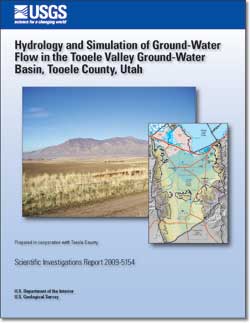 Abstract Abstract
Ground water is the sole source of drinking water within Tooele Valley. Transition from agriculture to residential land and water use necessitates additional understanding of water resources. The ground-water basin is conceptualized as a single interconnected hydrologic system consisting of the consolidated-rock mountains and adjoining unconsolidated basin-fill valleys. Within the basin fill, unconfined conditions exist along the valley margins and confined conditions exist in the central areas of the valleys. Transmissivity of the unconsolidated basin-fill aquifer ranges from 1,000 to 270,000 square feet per day. Within the consolidated rock of the mountains, ground-water flow largely is unconfined, though variability in geologic structure, stratigraphy, and lithology has created some areas where ground-water flow is confined. Hydraulic conductivity of the consolidated rock ranges from 0.003 to 100 feet per day.
Ground water within the basin generally moves from the mountains toward the central and northern areas of Tooele Valley. Steep hydraulic gradients exist at Tooele Army Depot and near Erda. The estimated average annual ground-water recharge within the basin is 82,000 acre-feet per year. The primary source of recharge is precipitation in the mountains; other sources of recharge are irrigation water and streams. Recharge from precipitation was determined using the Basin Characterization Model. Estimated average annual ground-water discharge within the basin is 84,000 acre-feet per year. Discharge is to wells, springs, and drains, and by evapotranspiration. Water levels at wells within the basin indicate periods of increased recharge during 1983–84 and 1996–2000. During these periods annual precipitation at Tooele City exceeded the 1971–2000 annual average for consecutive years.
The water with the lowest dissolved-solids concentrations exists in the mountain areas where most of the ground-water recharge occurs. The principal dissolved constituents are calcium and bicarbonate. Dissolved-solids concentration increases in the central and northern parts of Tooele Valley, at the distal ends of the ground-water flow paths. Increased concentration is due mainly to greater amounts of sodium and chloride. Deuterium and oxygen-18 values indicate water recharged primarily from precipitation occurs throughout the ground-water basin. Ground water with the highest percentage of recharge from irrigation exists along the eastern margin of Tooele Valley, indicating negligible recharge from the adjacent consolidated rock. Tritium and tritiogenic helium-3 concentrations indicate modern water exists along the flow paths originating in the Oquirrh Mountains between Settlement and Pass Canyons and extending between the steep hydraulic gradient areas at Tooele Army Depot and Erda. Pre-modern water exists in areas east of Erda and near Stansbury Park. Using the change in tritium along the flow paths originating in the Oquirrh Mountains, a first-order estimate of average linear ground-water velocity for the general area is roughly 2 to 5 feet per day.
A numerical ground-water flow model was developed to simulate ground-water flow in the Tooele Valley ground-water basin and to test the conceptual understanding of the ground-water system. Simulating flow in consolidated rock allows recharge and withdrawal from wells in or near consolidated rock to be simulated more accurately. In general, the model accurately simulates water levels and water-level fluctuations and can be considered an adequate tool to help determine the valley-wide effects on water levels of additional ground-water withdrawal and changes in water use. The simulated increase in storage during a projection simulation using 2003 withdrawal rates and average recharge indicates that repeated years of average precipitation and recharge conditions do not completely restore the system after multiple years of below-normal precipitation. In the similar case where precipitation is 90 percent of average, water levels throughout most of Tooele Valley are projected to be as much as 50 feet lower. Water levels are projected to be at least 10 feet lower basin wide, and as much as 260 feet lower over most of the southeastern part of Tooele Valley, due to projected increases in well withdrawals. Particle tracking indicates that projected reduced recharge or increased withdrawals do not change the direction of ground-water flow from areas of high dissolved-solids concentration.
|
Part or all of this report is presented in Portable Document Format (PDF); the latest version of Adobe Reader or similar software is required to view it. Download the latest version of Adobe Reader, free of charge. |